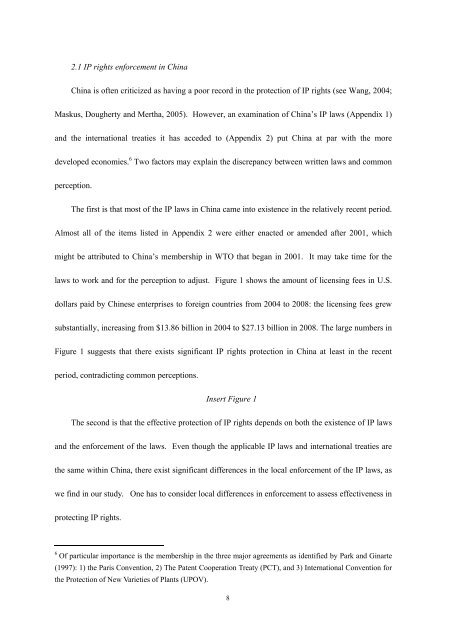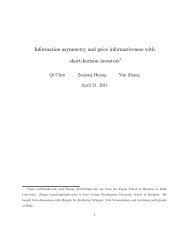Does Enforcement of Intellectual Property Rights Matter in China ...
Does Enforcement of Intellectual Property Rights Matter in China ...
Does Enforcement of Intellectual Property Rights Matter in China ...
You also want an ePaper? Increase the reach of your titles
YUMPU automatically turns print PDFs into web optimized ePapers that Google loves.
2.1 IP rights enforcement <strong>in</strong> Ch<strong>in</strong>a<br />
Ch<strong>in</strong>a is <strong>of</strong>ten criticized as hav<strong>in</strong>g a poor record <strong>in</strong> the protection <strong>of</strong> IP rights (see Wang, 2004;<br />
Maskus, Dougherty and Mertha, 2005). However, an exam<strong>in</strong>ation <strong>of</strong> Ch<strong>in</strong>a’s IP laws (Appendix 1)<br />
and the <strong>in</strong>ternational treaties it has acceded to (Appendix 2) put Ch<strong>in</strong>a at par with the more<br />
developed economies. 6 Two factors may expla<strong>in</strong> the discrepancy between written laws and common<br />
perception.<br />
The first is that most <strong>of</strong> the IP laws <strong>in</strong> Ch<strong>in</strong>a came <strong>in</strong>to existence <strong>in</strong> the relatively recent period.<br />
Almost all <strong>of</strong> the items listed <strong>in</strong> Appendix 2 were either enacted or amended after 2001, which<br />
might be attributed to Ch<strong>in</strong>a’s membership <strong>in</strong> WTO that began <strong>in</strong> 2001. It may take time for the<br />
laws to work and for the perception to adjust. Figure 1 shows the amount <strong>of</strong> licens<strong>in</strong>g fees <strong>in</strong> U.S.<br />
dollars paid by Ch<strong>in</strong>ese enterprises to foreign countries from 2004 to 2008: the licens<strong>in</strong>g fees grew<br />
substantially, <strong>in</strong>creas<strong>in</strong>g from $13.86 billion <strong>in</strong> 2004 to $27.13 billion <strong>in</strong> 2008. The large numbers <strong>in</strong><br />
Figure 1 suggests that there exists significant IP rights protection <strong>in</strong> Ch<strong>in</strong>a at least <strong>in</strong> the recent<br />
period, contradict<strong>in</strong>g common perceptions.<br />
Insert Figure 1<br />
The second is that the effective protection <strong>of</strong> IP rights depends on both the existence <strong>of</strong> IP laws<br />
and the enforcement <strong>of</strong> the laws. Even though the applicable IP laws and <strong>in</strong>ternational treaties are<br />
the same with<strong>in</strong> Ch<strong>in</strong>a, there exist significant differences <strong>in</strong> the local enforcement <strong>of</strong> the IP laws, as<br />
we f<strong>in</strong>d <strong>in</strong> our study. One has to consider local differences <strong>in</strong> enforcement to assess effectiveness <strong>in</strong><br />
protect<strong>in</strong>g IP rights.<br />
6 Of particular importance is the membership <strong>in</strong> the three major agreements as identified by Park and G<strong>in</strong>arte<br />
(1997): 1) the Paris Convention, 2) The Patent Cooperation Treaty (PCT), and 3) International Convention for<br />
the Protection <strong>of</strong> New Varieties <strong>of</strong> Plants (UPOV).<br />
8



